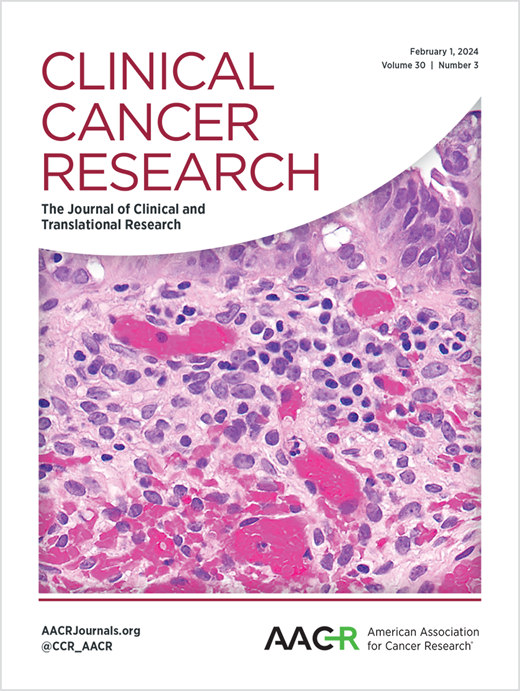晚期鼻窦鳞状细胞癌诱导化疗 II 期试验
IF 10
1区 医学
Q1 ONCOLOGY
引用次数: 0
摘要
目的:晚期鼻窦鳞状细胞癌(SCC)初次手术后的疗效不佳。我们测试了诱导化疗(IC)能否改善疾病控制或器官保存。患者和方法:一项II期试验评估了既往未经治疗的II-IV期M0鼻窦SCC患者。患者接受多西他赛、顺铂和氟尿嘧啶的IC治疗,有反应者接受化学放疗(CRT),无反应者接受手术和辅助放疗或CRT。主要终点是总反应率(ORR)和局部控制率(LRC)。次要终点包括无进展生存期(PFS)、总生存期(OS)、器官保存和治疗毒性。结果:在2008年至2020年间入组的31名患者中,有28人接受了疗效评估。分别有57%、21%和36%的患者病情为T4a、T4b和N+。ORR为82.1%;17.9%的患者病情稳定,0%的患者病情进展。分别有54%和18%的患者出现3级和4级不良事件(AE),没有5级不良事件。2年的LRC和PFS率分别为64.3%(95% CI 40.4-77.6)和52.4%(95% CI 32.3-69.0)。中位 PFS 为 25.8 个月。中位OS为47.4个月,2年OS率为69.4%(95% CI 44.9-80.4)。手术与 CRT 的生存率无差异(危险比 1.07,95% CI 0.9-3.84)。在2年存活的患者中,63%实现了器官保留,避免了上颌骨切除术(38%)、开颅手术(13%)或眶外扩张术(38%)。结论IC和反应导向治疗为晚期鼻窦SCC患者带来了良好的疾病控制和器官保护效果。本文章由计算机程序翻译,如有差异,请以英文原文为准。
Phase II Trial of Induction Chemotherapy for Advanced Sinonasal Squamous Cell Carcinoma
Purpose: Outcomes after primary surgery for advanced sinonasal squamous cell carcinoma (SCC) are poor. We tested whether induction chemotherapy (IC) can improve disease control or organ preservation. Patients and Methods: A phase II trial evaluated previously untreated patients with stage II-IV, M0 sinonasal SCC. Patients received IC with docetaxel, cisplatin, and fluorouracil, followed by chemoradiotherapy (CRT) for responders and surgery with adjuvant radiotherapy or CRT for non-responders. The primary endpoints were overall response rate (ORR) and locoregional control (LRC). Secondary endpoints included progression-free survival (PFS), overall survival (OS), organ preservation, and treatment toxicity. Results: Of the 31 patients enrolled between 2008 and 2020, 28 were evaluated for efficacy. Disease was T4a, T4b, and N+ in 57%, 21%, and 36% of patients, respectively. The ORR was 82.1%; 17.9% of patients had stable disease, and 0% had progressive disease. Grade 3 and 4 adverse events (AE) occurred in 54% and 18% of patients, respectively; there were no Grade 5 AEs. The 2-year LRC and PFS rates were 64.3% (95% CI 40.4-77.6) and 52.4% (95% CI 32.3-69.0), respectively. The median PFS was 25.8 months. The median OS was 47.4 months, with a 2-year OS rate of 69.4% (95% CI 44.9-80.4). No survival difference was observed between surgery versus CRT (hazard ratio 1.07, 95% CI 0.9-3.84). Of patients alive at 2 years, 63% achieved organ preservation, avoiding maxillectomy (38%), craniotomy (13%), or orbital exenteration (38%). Conclusions: IC and response-directed treatment achieved promising disease control and added organ preservation for patients with advanced sinonasal SCC.
求助全文
通过发布文献求助,成功后即可免费获取论文全文。
去求助
来源期刊

Clinical Cancer Research
医学-肿瘤学
CiteScore
20.10
自引率
1.70%
发文量
1207
审稿时长
2.1 months
期刊介绍:
Clinical Cancer Research is a journal focusing on groundbreaking research in cancer, specifically in the areas where the laboratory and the clinic intersect. Our primary interest lies in clinical trials that investigate novel treatments, accompanied by research on pharmacology, molecular alterations, and biomarkers that can predict response or resistance to these treatments. Furthermore, we prioritize laboratory and animal studies that explore new drugs and targeted agents with the potential to advance to clinical trials. We also encourage research on targetable mechanisms of cancer development, progression, and metastasis.
 求助内容:
求助内容: 应助结果提醒方式:
应助结果提醒方式:


